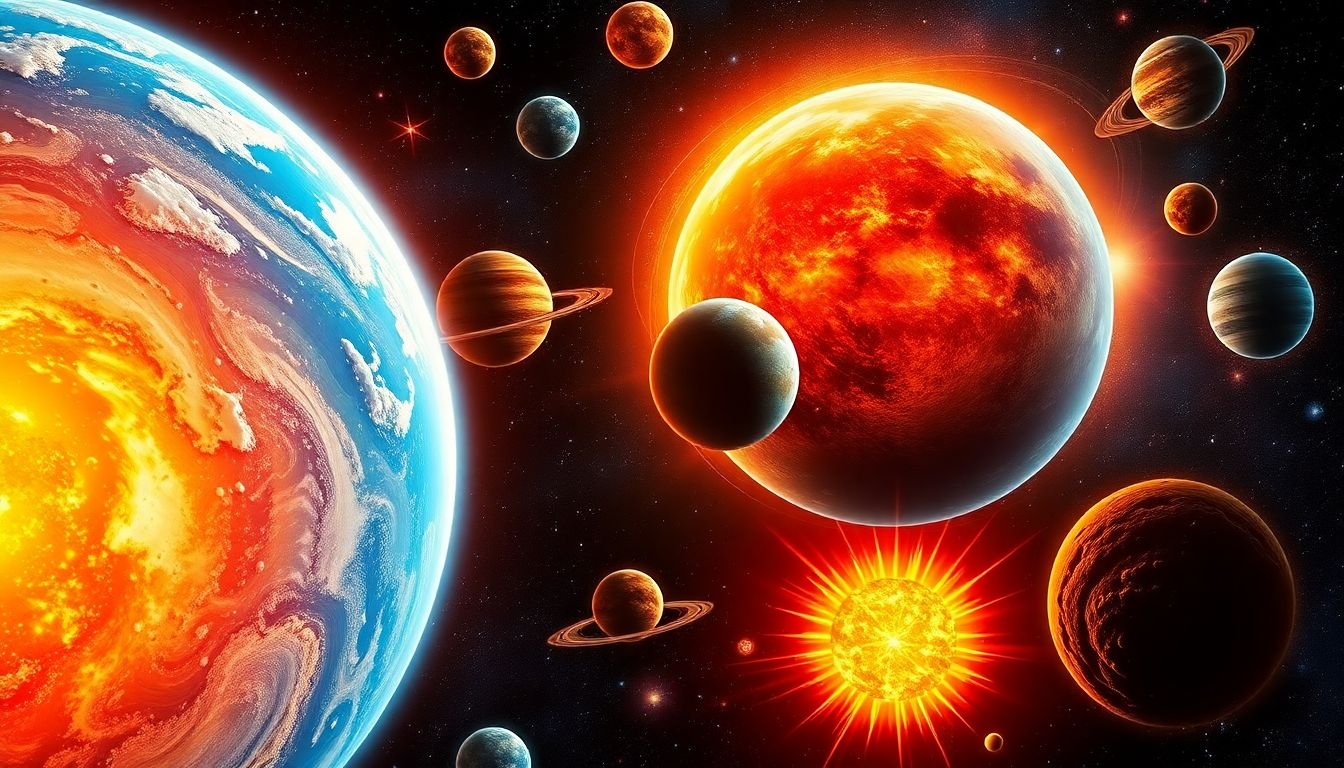
How Are Planets and Stars Different but Sometimes Alike? A Comprehensive Exploration
Introduction
The night sky has fascinated humans for thousands of years. Think about how many stories and myths have been made around the moon, stars, and planets. These celestial bodies aren’t just beautiful; they are key to understanding our universe. Today, we’ll look at how planets and stars compare. You’ll see what makes them different and why, in some ways, they are similar. This knowledge helps us grasp our place in space and the bigger picture of cosmic life.
What Are Planets and Stars? Definitions and Basic Characteristics
Differences in Definitions
A planet is a space body that circles a star. It’s rounded because of its gravity. It has cleared out most other objects in its path. Experts like NASA define planets as objects that are big enough to be shaped by gravity and that orbit around a star.
Stars are huge, glowing spheres of plasma that send out light and heat. They generate energy through nuclear fusion. Think of stars as big furnaces burning hot gases millions of miles away. The European Space Agency (ESA) describes stars as self-luminous celestial bodies powered by nuclear reactions.
Basic Physical Characteristics
Planets are smaller and less heavy than stars. They are made of rock, metal, ice, and gases. You can see planets with binoculars or telescopes, but they don’t shine on their own — they reflect the light from nearby stars.
Stars shine brightly because they produce their own light. They are huge, often thousands of times larger than planets. Their brightness depends on their size and how much energy they make.
Formation and Lifecycle: How Planets and Stars Come into Existence
Formation Processes
Stars form from giant gas clouds called nebulae. Gravity pulls the gas and dust together. Over time, these collapse into a dense core that becomes a star, like our Sun.
Planets form in the disks of dust and gas surrounding young stars. This process, called accretion, gathers tiny particles into larger bodies. Our Solar System formed this way, with planets orbiting the Sun.
Lifecycle Stages
Stars start as protostars, then settle into the main sequence phase, where they shine steadily. When they run out of fuel, they grow into red giants or explode as supernovae, leaving behind remnants like neutron stars or black holes.
Planets don’t have such dramatic endings. They evolve slowly, experiencing geological changes, atmospheric shifts, and sometimes volcanic eruptions. Some planets may support life, like Earth, but most change very gradually over billions of years.
Physical and Structural Differences
Composition and Material Differences
Stars are mostly made of hydrogen and helium gases. Inside, nuclear fusion occurs in their cores, creating energy.
Planets contain rock, metals, and ice. Their atmospheres can be thick or thin, depending on their distance from the star and size.
Size and Mass Comparison
Stars are giant compared to planets. For example, our Sun is about 109 times wider than Earth. Stars can be thousands of times more massive than planets, influencing everything around them.
Surface and Internal Structures
Stars have gaseous surfaces, and their energy is generated deep inside through fusion. They don’t have solid surfaces like planets.
Planets are either solid with crusts or layered interiors. Their cores are often made of metal, with crusts of rock or ice.
Similarities Between Planets and Stars
Both Are Celestial Bodies in Space
Both planets and stars belong to galaxies like our Milky Way. They drift through space, part of the cosmic scenery.
Light and Energy Emission
Stars produce their own glow by burning gases via nuclear fusion. Some planets reflect the star’s light and emit heat, like Earth does.
Role in the Cosmic Ecosystem
Stars are key to creating planets. Without stars, planets couldn’t orbit or have life-supporting conditions. Both types influence the evolution of planetary systems.
Key Differences That Define Their Unique Roles
Brightness and Energy Production
Stars shine all on their own—bright and hot. Planets rely on nearby stars’ light to be visible.
Nuclear Fusion vs. Geophysical Processes
The power behind stars is nuclear fusion deep inside. Planets change mainly through geological processes, like earthquakes or volcanic activity.
Habitability and Life Potential
Stars supply the energy needed for planets to support life. But not all planets are suitable; they need the right conditions to host living things.
Real-World Examples of Planets and Stars
The Sun and Its Planets
The Sun is our closest star. Around it, planets like Earth, Mars, and Jupiter orbit, each with unique features.
Notable Stars and Their Systems
Other well-known stars include Alpha Centauri, Sirius, and Betelgeuse. They sometimes host exoplanets — planets orbiting stars other than the Sun.
Observation and Study
Scientists use telescopes like Hubble or space missions like Kepler to study these bodies. These tools reveal details about their size, composition, and behavior.
Expert Insights and Scientific Perspectives
Famous astronomer Carl Sagan once said, “We are made of star stuff,” highlighting how stars and planets are connected. Recent discoveries, like new exoplanets or star behaviors, deepen our understanding. Ongoing research continues to surprise us about their similarities and differences.
Practical Tips for Observing and Understanding Celestial Bodies
If you love stargazing, start with a good telescope or binoculars. Use star charts or astronomy apps to identify planets and stars visible tonight. Best viewing times are early evenings or clear nights away from city lights. Educational programs at planetariums or online courses can teach you more about our universe.
Conclusion
Planets and stars may seem very different. Stars are hot, bright, and capable of creating their own energy through nuclear fusion. Planets are smaller, reflect light, and orbit stars. However, they also share a place in the universe. Both are essential to the cosmic story—forming, evolving, and shaping the galaxies we see. Understanding both types of celestial bodies helps us appreciate the universe and our own place within it. Keep exploring the night sky, and you’ll discover many more incredible sights and facts about space.

